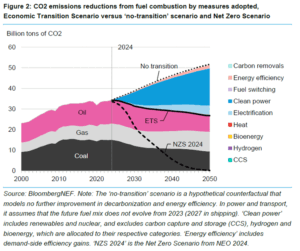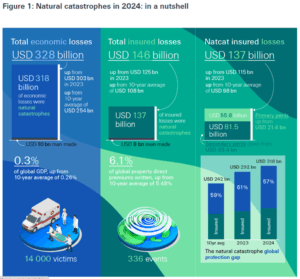New guidelines for resilient cities, dealing with Scope 3 and another new renewable
In this issue:
Global electricity demand to increase 75%
The Bloomberg New Energy Finance New Energy Outlook 2025 is out. Among its key predictions are that oil demand will peak in 2032, but will decline only 15% by 2050, far short of what is needed for net zero by the same time. While coal demand is expected to fall sharply, demand for natural gas is predicted to increase 25%. Renewable generation is expected to increase 84% by 2030 and then double again by 2050 on the back of a 75% increase in electricity demand, heavily driven by the expansion of EVs and data centres. Boosting efficiency and flexibility will be critical to reducing emissions according to the report. Technologies listed as having limited impact include carbon capture and hydrogen.
Scope 3 Code of Practice launched
The Voluntary Carbon Market Initiative published its new guidance on Scope 3 emissions this week. The Code focuses on how companies can address their unabated Scope 3 emissions using high-quality carbon credits. Its position is that companies should have overcome hurdles in abating Scope 3 emissions by 2040 but, in the interim, should use offsetting.
Resilience guidelines for cities
A new Standard for urban resilience has just been published by BSI. ISO 22371:2024 Security and resilience. Community resilience. Principles, framework and guidelines on urban resilience, while a bit of a mouthful of a title, should be a must-read for urban local authorities facing increasing risks of severe weather events. The guidelines cover things like governance structures, developing strategies and plans, their testing and then monitoring and measuring impact.
Natural catastrophe costs through the roof
A report just published by major global reinsurer Swiss Re tells us the cost of natural catastrophes, including earthquakes, hurricanes, floods and wildfires, continues to increase at an alarming rate. For 2024, it estimates the total economic cost of natural catastrophes hit US$328bn (NZ$555bn), an increase of over 8% for the year. Of that, US$137bn (NZ$232bn) was insured. With 2025 kicking off with the Los Angeles wildfires, it is predicting this year will be up again. Its current estimate is for insured losses to hit US$145bn (NZ$245) in 2025, significantly more if there is a major earthquake or bad hurricane season.
Energy Security Summit concludes
New Zealand was one of 60 countries that attended the Summit on the Future of Energy Security in London recently. The key conclusion of the summit was that the energy transition is here to stay and will boost energy security, and therefore national security, for almost everyone. Noticeably absent was China, and the US involvement was very low key.
Tilted landscape for windmills
The Global Wind Energy Association has just published its annual report for 2024 revealing a record number of new installations in the year at 117GW. However, it also warned of a significant imbalance in new capacity building. China, the US, Germany, India and Brazil saw the biggest growth but there was little building in less developed countries, put down to poor infrastructure and regulatory environments.
Power from rain – without a turbine
Scientists at the National University of Singapore have developed a technique for harvesting electricity from water without the use of a mechanical converter such as a turbine. They have established that as small droplets, or plugs, flow down a tube they generate a small, but harvestable charge in a way not dissimilar to generating static electricity with a balloon. Their trial system converted 10% of the energy from the falling water into electricity.
Did you know ……..
Of the 195 signatory countries of the Paris Agreement, only 19 have so far submitted their revised NDCs which were due at the start of the year.



